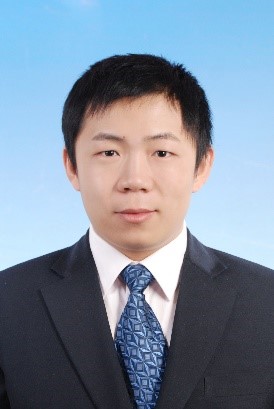Azobenzenes as energy transducers in dynamic supramolecular systems
He Huang is PhD-Student in the Biomolecular Nanotechnology Research Group. His supervisor is Nathalie Katsonis from the Faculty of Science and Technology.
 Interfacing molecular photo-switches with supramolecular systems allows developing dynamic smart materials with photo-responsive functions, provided that the energy input from photo-illumination can be converted into different forms, and amplified across multiple length scales. In this thesis, we focus on azobenzene photo-switches as dynamic building blocks, in view of their easy synthesis and functionalization, high extinction coefficient and quantum yields, as well as the changes on both molecular geometry and dipole moment during the photo-isomerization process. A main challenge remaining with the lack of cis- isomer stability, which limits the application by losing the encoded cis- state information. Meanwhile UV-light irradiation is unfavored in bio-environment due to the tissue harmful issue. Thus, we started with study on fluorinated azobenzenes, for their application in supramolecular materials for kinetic control and visible-light controlled switching.
Interfacing molecular photo-switches with supramolecular systems allows developing dynamic smart materials with photo-responsive functions, provided that the energy input from photo-illumination can be converted into different forms, and amplified across multiple length scales. In this thesis, we focus on azobenzene photo-switches as dynamic building blocks, in view of their easy synthesis and functionalization, high extinction coefficient and quantum yields, as well as the changes on both molecular geometry and dipole moment during the photo-isomerization process. A main challenge remaining with the lack of cis- isomer stability, which limits the application by losing the encoded cis- state information. Meanwhile UV-light irradiation is unfavored in bio-environment due to the tissue harmful issue. Thus, we started with study on fluorinated azobenzenes, for their application in supramolecular materials for kinetic control and visible-light controlled switching.
In Chapter 1, we present a brief overview of commonly used molecular photo-switches.
In Chapter 2, we discuss recent designing and engineering strategies that aim at developing cis- stable azobenzenes. These strategies include ortho-fluorination, ortho-methoxylation, azoheteroarene, hydrazone and azobenzene-BF2 conjugation, cyclic azobenzene.
In Chapter 3, two strategies, ortho-fluorination and axial chirality, are combined to in azobenzene-based dynamic dopants for liquid crystals. In both isotropic solution and in the liquid crystalline phase, these chiral dopants display better cis-form stability than their non-fluorinated counterparts. In the liquid crystalline phase, long-lived helical structures with cis- state dopant could be created by irradiation. However, the fluorinated dopants remain associated with moderate helical twisting powers and variations thereof, upon photo-isomerization in cholesteric liquid crystals. This cholesteric liquid crystal will be potentially applied into optical displaydevices or photo-responsive actuators.
In Chapter 4, we investigate the host-guest chemistry of ortho-fluorinated azobenzenes in two common host cavities: β-cyclodextrin and cucurbit[8]uril. In the presence of both host cavities, ortho-fluorinated azobenzenes form stable supramolecular complexes. In the trans-form, binding to β-cyclodextrin is favored, whereas in its cis-form complexation to cucurbit[8]uril is favored. Upon light-triggered photo-isomerization, we show that the photoswitch can be transferred from one host cavity to the other, reversibly.
In Chapter 5, the host-guest chemistry of ortho-fluorinated azobenzenes was involved in the design of multivalent architectures, with the final aim to build dynamic supramolecular nanoparticles that would display photo-triggered self-assembly. In the bi-componenet system composed by fluorinated azobenzenes and β-cyclodextrins, the binding constant is of the same order of magnitude in both the trans- and the cis-state, thus the supramolecular nanoparticles show no response to photo-isomerization. Cucurbit[8]uril was then introduced into the system to bind with cis-azobenzene we anticipated that the supramolecular nanoparticles would dis-assemble by competitive complexation. However, the binding between the azobenzene and β-cyclodextrin is enhanced by multivalency effects, thus the cucurbit[8]uril could not compete against β-cyclodextrin in the host guest complexation, and the supramolecular system remained non photo-responsive.
Another broadly interested question nowadays is the stimuli controlled dynamic assembly and dispersion. In Chapter 6, azobenzene-based photo-switches are employed as photo-responsive ligands for nanoplatelets of an inorganic semi-conductor. Upon irradiation, the dipole-dipole interaction between cis- azobenzenes induced face-to-face self-assembly of the nanoplatelets, into supra-particular ribbons. The next step investigation will befocused on mechanism of the ribbons-formation and deformation, as well as the fluorescence-luminescence behavior of the stacking ribbons.
Overall, this thesis demonstrates a bottom-up approach to build dynamic smart materials, from molecular engineering of azobenzene-based switches to their integration into different types of supramolecular materials including liquid crystals, host-guest complexes and colloidal inorganic nano-objects. The future work will keep on developing new engineering strategies and methods of molecular switches, as well as the study of mechanism of transducing molecular switching across multiple length scales.





